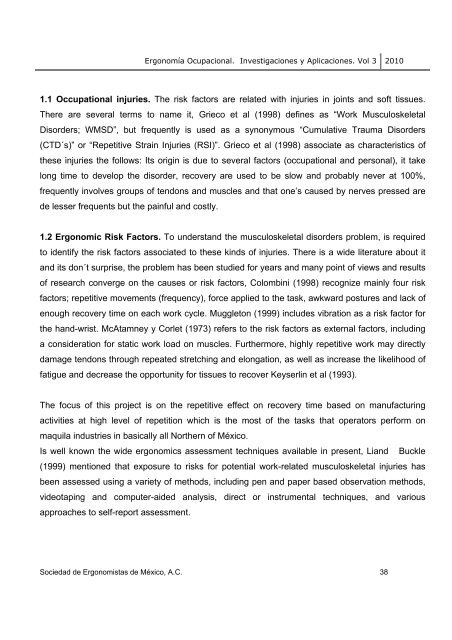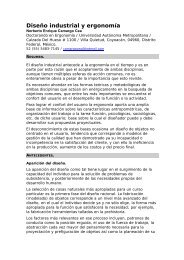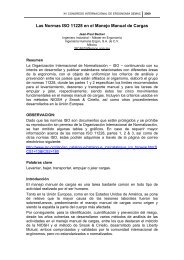ERGONOMÍA OCUPACIONAL - SOCIEDAD DE ERGONOMISTAS ...
ERGONOMÍA OCUPACIONAL - SOCIEDAD DE ERGONOMISTAS ...
ERGONOMÍA OCUPACIONAL - SOCIEDAD DE ERGONOMISTAS ...
You also want an ePaper? Increase the reach of your titles
YUMPU automatically turns print PDFs into web optimized ePapers that Google loves.
Ergonomía Ocupacional. Investigaciones y Aplicaciones. Vol 3 2010<br />
1.1 Occupational injuries. The risk factors are related with injuries in joints and soft tissues.<br />
There are several terms to name it, Grieco et al (1998) defines as “Work Musculoskeletal<br />
Disorders; WMSD”, but frequently is used as a synonymous “Cumulative Trauma Disorders<br />
(CTD´s)” or “Repetitive Strain Injuries (RSI)”. Grieco et al (1998) associate as characteristics of<br />
these injuries the follows: Its origin is due to several factors (occupational and personal), it take<br />
long time to develop the disorder, recovery are used to be slow and probably never at 100%,<br />
frequently involves groups of tendons and muscles and that one’s caused by nerves pressed are<br />
de lesser frequents but the painful and costly.<br />
1.2 Ergonomic Risk Factors. To understand the musculoskeletal disorders problem, is required<br />
to identify the risk factors associated to these kinds of injuries. There is a wide literature about it<br />
and its don´t surprise, the problem has been studied for years and many point of views and results<br />
of research converge on the causes or risk factors, Colombini (1998) recognize mainly four risk<br />
factors; repetitive movements (frequency), force applied to the task, awkward postures and lack of<br />
enough recovery time on each work cycle. Muggleton (1999) includes vibration as a risk factor for<br />
the hand-wrist. McAtamney y Corlet (1973) refers to the risk factors as external factors, including<br />
a consideration for static work load on muscles. Furthermore, highly repetitive work may directly<br />
damage tendons through repeated stretching and elongation, as well as increase the likelihood of<br />
fatigue and decrease the opportunity for tissues to recover Keyserlin et al (1993).<br />
The focus of this project is on the repetitive effect on recovery time based on manufacturing<br />
activities at high level of repetition which is the most of the tasks that operators perform on<br />
maquila industries in basically all Northern of México.<br />
Is well known the wide ergonomics assessment techniques available in present, Liand Buckle<br />
(1999) mentioned that exposure to risks for potential work-related musculoskeletal injuries has<br />
been assessed using a variety of methods, including pen and paper based observation methods,<br />
videotaping and computer-aided analysis, direct or instrumental techniques, and various<br />
approaches to self-report assessment.<br />
Sociedad de Ergonomistas de México, A.C. 38




